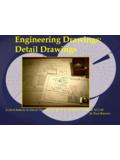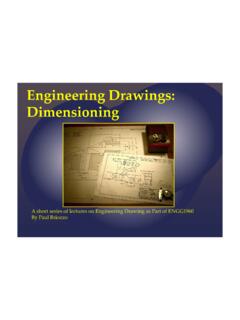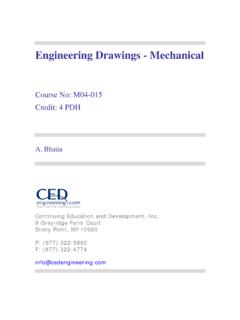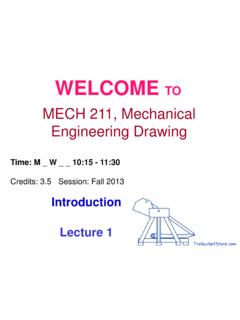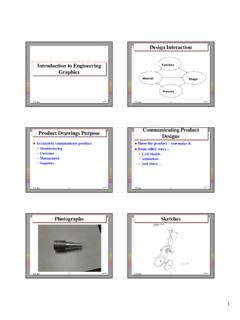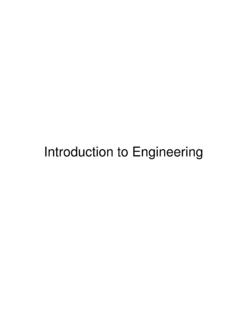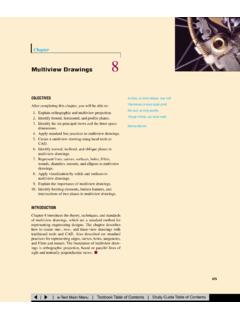Transcription of MECH2400 5400 Engineering Drawings Lecture Introduction
1 Engineering DrawingsA short series of lectures on Engineering Drawing as Part of ENGG1960 Introduction to Biomedical Engineering 1 By Paul BriozzoWhat is an Engineering Drawing ?An Engineering Drawing is a technical (not artistic) drawing whichclearly defines and communicates a design to other interested parties. Other parties may have an interest in design collaboration, procurement / purchasing,costing, manufacturing, quality control, marketing, handling / do we need to know about Engineering Drawings ? To allow our designs to develop from a thought or concept to a design / sketch on paper . To enable us to communicate our designs / sketches to colleagues for review. To convert our sketches / designs into layout Drawings which show how our ideas link up to existing infrastructures. To include our design / sketches as part of a proposal for client / management approval and review.
2 To provide Manufacturers with working Engineering Drawings based from our original designs / sketches. Consider the following description of a V Block MATERIAL: CAST IRONP ictorial FreehandExamples of Layout Drawings Collapsible Canoe Outrigger Design Project, 1998 Undergraduate Design Project under the Leadership of A/Prof. Harry Lipkin, Georgia Tech UniversityLunar Module Landing Gear Plans, NASA, 1969 Examples of Layout Drawings Proposal Drawing Engineering drawing by Harry C. Shoaf (Space Task Group Engineering Division) of the proposed lunar lander to be used with an advanced version of the Mercury spacecraft. (Shoaf, Drawing, Nov. 15, 1961.) Surveyor 1 ,1966 Lunar Lander, 1969 Engineering Drawing Detail Drawing (Finish Drawing) of Connecting Rod, 1973 The History of Engineering Drawing Free Hand Sketches Leonardo DaVinci 1500 ADSforza monumentAnatomical study of the arm c1510 RhombicuboctahedronDesign for a flying machine c1488 Graphical ProjectionsProjectionsAxonometric/Isomet ricOrthographicObliqueParallel ProjectionPerspectiveOrthogonal1stAngle2 ndAngle3rdAngle4thAnglePerspectiveStairc ase two point perspectiveCube two point perspectiveCube one point perspectiveCube two point perspectiveCube two point perspectiveMethod and Rules of Projections Select a view from the most advantageous position.
3 Observe overall structure first. Note: parallelism, proportions and of Projection Object viewed from . Parallel lines remain parallel. Proportions remain unchanged. Circles are always ellipses with the major axis of ellipse perpendicular to the polar axis of circle. Transformation of 90 ProjectionAxonometric/IsometricOrthograp hicObliqueParallel ProjectionOrthogonal1stAngle2ndAngle3rdA ngle4thAngleOblique Projection Cavalier views are not preferred. They show lines which represent the depth of the object as being disproportionally long. Even though they are parallel to each other, depth lines appear to diverge away from each other. Cabinet views are preferred over Cavalier. The issue of depth disproportionality and divergence is somewhat eliminated by halving the depth ProjectionCavalier and Cabinet ProjectionsCavalierCabinetOblique Projection4 Basic Rules1. Place the object so that the view with the most detail is parallel to the picture plane.
4 2. Place the object so that the longest dimension runs horizontally across the sheet. Oblique Projection4 Basic Rules3. In some cases the previous rules conflict, and when this is so, Rule 1 has preference as the advantage gained by having the irregular face without distortion is greater than that gained by observing Rule 2. 4. Decisions about viewing an object in oblique projection should aim to show the object so that its shape is most clearly presented and is conducive to showing its Projection Projection lines are perpendicular to Projection Plane. Principal axes inclined to Projection Plane. Isometric (Equal Scaling) Dimetric TrimetricIsometric DimetricOrthographicOrthogonal1stAngle2n dAngle3rdAngle4thAngleOrthogonal Projection3rdAngle Projection1stAngle Projection Emok 26thof June 2008 Dihedral Angles 1stAngle EmphasisedFree Hand Pictorial Sketching Design Handbook: Engineering Drawing and Sketching MIT Open Courseware Design Handbook: Engineering Drawing and Sketching MIT Open CoursewareWhy do we need to do this when we all have cameras on our mobile phones and can sketch on our tablets ?
5 Note some of the features and differences between the SolidWorks rendering and the photo ShadowsFocusLack of parallel lines adds distortionHidden featuresReflectionScratches / stains / blemishesConstruction of Freehand Pictorial Sketching The Thing Suitable Drawing SizeLine Drawing only (No Shading)Line QualityThree Faces Visible (The faces which show most detail)Lines that are parallel on the object should be parallel on the sketchProportions of features within the object must remain the sameSketching a bounding box for an ellipse Box defines the perimeter of the cylinderDefine two axis midway and parallel to each side of the boxMinor axis (or Polar axis) of the ellipse goes through the intersection of the two axis and is parallel to the edge of the boxMinor axis does NOT go through the corners of the boxSketching an ellipse Sketch ellipse noting that minor and major axis define outer limits of the ellipseDefine major axis of the ellipse going through theintersection point and at 90 to the minor axisEllipse curves do NOT necessarily blend at the intersection points Projecting an ellipse Remove all construction linesProject the ellipse forward to the correct distance along the bossTrace the ellipse in the new position and erase the hidden arcs from the original ellips
